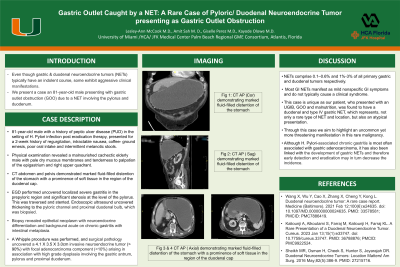Tuesday Poster Session
Category: Stomach
P4249 - Gastric Outlet Caught by a NET: A Rare Case of Pyloric/Duodenal Neuroendocrine Tumor Presenting as Gastric Outlet Obstruction
Tuesday, October 24, 2023
10:30 AM - 4:00 PM PT
Location: Exhibit Hall

Has Audio

Lesley-Ann McCook, MD
University of Miami
Atlantis, FL
Presenting Author(s)
Lesley- Ann McCook, MD1, Amit Sah, MD1, Giselle Perez, MD2, Kayode Olowe, MD3
1University of Miami, Atlantis, FL; 2University of Miami/HCA Florida JFK Hospital, Deerfield Beach, FL; 3HCA Healthcare, Atlantis, FL
Introduction: Gastric & duodenal neuroendocrine tumors (NETs) are rare lesions derived from the enterochromaffin-like cells of the gastroenteropancreatic neuroendocrine system. Even though GI NETs typically have an indolent course, some exhibit aggressive clinical manifestations. We present a case of an 81-year-old male presenting with gastric outlet obstruction (GOO) due to a NET involving the pylorus and duodenum.
Case Description/Methods: 81-year-old male with a history of peptic ulcer disease (PUD) in the setting of H. Pylori infection post eradication therapy, presented for a 2-week history of regurgitation, intractable nausea, coffee- ground emesis, poor oral intake and intermittent melanotic stools. Physical examination revealed a malnourished cachectic elderly male with pale dry mucous membranes and tenderness to palpation of the epigastrium and right upper quadrant. CT abdomen and pelvis demonstrated marked fluid-filled distention of the stomach with a prominence of soft tissue in the region of the duodenal cap. EGD performed uncovered localized severe gastritis in the prepyloric region and significant stenosis at the level of the pylorus. This was traversed and stented. Endoscopic ultrasound uncovered thickening to the pyloric channel and proximal duodenal bulb, which was biopsied. Biopsy revealed epithelial neoplasm with neuroendocrine differentiation and background acute on chronic gastritis with intestinal metaplasia. A Whipple procedure was performed, and surgical pathology uncovered a 4.1 X 3.5 X 3.0cm invasive neuroendocrine tumor ( > 90%) with focal adenocarcinoma component (< 10%) arising in association with high grade dysplasia involving the gastric antrum, pylorus and proximal duodenum.
Discussion: NETs comprise 0.1–0.6% and 1%-3% of all primary gastric and duodenal tumors respectively. Most GI NETs manifest as mild nonspecific GI symptoms and do not typically cause a clinical syndrome. This case is unique as our patient, who presented with an UGIB, GOO and malnutrition, was found to have a duodenal and type IV gastric NET, which represents, not only a rare type of NET and location, but also an atypical presentation. Through this case we aim to highlight an uncommon yet more threatening manifestation in this rare malignancy. Although H. Pylori-associated chronic gastritis is most often associated with gastric adenocarcinoma, it has also been linked with the development of gastric NETs and therefore early detection and eradication may in turn decrease the incidence.
Disclosures:
Lesley- Ann McCook, MD1, Amit Sah, MD1, Giselle Perez, MD2, Kayode Olowe, MD3. P4249 - Gastric Outlet Caught by a NET: A Rare Case of Pyloric/Duodenal Neuroendocrine Tumor Presenting as Gastric Outlet Obstruction, ACG 2023 Annual Scientific Meeting Abstracts. Vancouver, BC, Canada: American College of Gastroenterology.
1University of Miami, Atlantis, FL; 2University of Miami/HCA Florida JFK Hospital, Deerfield Beach, FL; 3HCA Healthcare, Atlantis, FL
Introduction: Gastric & duodenal neuroendocrine tumors (NETs) are rare lesions derived from the enterochromaffin-like cells of the gastroenteropancreatic neuroendocrine system. Even though GI NETs typically have an indolent course, some exhibit aggressive clinical manifestations. We present a case of an 81-year-old male presenting with gastric outlet obstruction (GOO) due to a NET involving the pylorus and duodenum.
Case Description/Methods: 81-year-old male with a history of peptic ulcer disease (PUD) in the setting of H. Pylori infection post eradication therapy, presented for a 2-week history of regurgitation, intractable nausea, coffee- ground emesis, poor oral intake and intermittent melanotic stools. Physical examination revealed a malnourished cachectic elderly male with pale dry mucous membranes and tenderness to palpation of the epigastrium and right upper quadrant. CT abdomen and pelvis demonstrated marked fluid-filled distention of the stomach with a prominence of soft tissue in the region of the duodenal cap. EGD performed uncovered localized severe gastritis in the prepyloric region and significant stenosis at the level of the pylorus. This was traversed and stented. Endoscopic ultrasound uncovered thickening to the pyloric channel and proximal duodenal bulb, which was biopsied. Biopsy revealed epithelial neoplasm with neuroendocrine differentiation and background acute on chronic gastritis with intestinal metaplasia. A Whipple procedure was performed, and surgical pathology uncovered a 4.1 X 3.5 X 3.0cm invasive neuroendocrine tumor ( > 90%) with focal adenocarcinoma component (< 10%) arising in association with high grade dysplasia involving the gastric antrum, pylorus and proximal duodenum.
Discussion: NETs comprise 0.1–0.6% and 1%-3% of all primary gastric and duodenal tumors respectively. Most GI NETs manifest as mild nonspecific GI symptoms and do not typically cause a clinical syndrome. This case is unique as our patient, who presented with an UGIB, GOO and malnutrition, was found to have a duodenal and type IV gastric NET, which represents, not only a rare type of NET and location, but also an atypical presentation. Through this case we aim to highlight an uncommon yet more threatening manifestation in this rare malignancy. Although H. Pylori-associated chronic gastritis is most often associated with gastric adenocarcinoma, it has also been linked with the development of gastric NETs and therefore early detection and eradication may in turn decrease the incidence.
Disclosures:
Lesley- Ann McCook indicated no relevant financial relationships.
Amit Sah indicated no relevant financial relationships.
Giselle Perez indicated no relevant financial relationships.
Kayode Olowe indicated no relevant financial relationships.
Lesley- Ann McCook, MD1, Amit Sah, MD1, Giselle Perez, MD2, Kayode Olowe, MD3. P4249 - Gastric Outlet Caught by a NET: A Rare Case of Pyloric/Duodenal Neuroendocrine Tumor Presenting as Gastric Outlet Obstruction, ACG 2023 Annual Scientific Meeting Abstracts. Vancouver, BC, Canada: American College of Gastroenterology.

